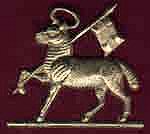LEATHERHEAD WAR MEMORIALS - WWI
Lance Corporal Albert Edwin (aka Edward) Taylor
1 Bn The Queen's (Royal West Surrey Regiment)
Town Memorial P9.R2.C1

Taken, Not Given, Liam Sumption, L&DLHS
L/CplAlbert E Taylor
2nd [sic] Royal West
Surrey Regt
Montauban
Aug 24 1916
Resorting again to the invaluable regimental records of the Queens, we learn that Albert Taylor's second Christian name was Edward, that he was born in Leatherhead, and like so many of the Queens, enlisted at Guildford. He was 'killed in action' serving with the 1st Bn. of the Queens, not the 2nd.
The Battalion's War Diary states that on 22nd August, two days prior to Albert Taylor's death, the Queens relieved the 9th H.L.I. (Highland Light Infantry) and that the relief was completed at 11 p.m. without casualties being incurred. (2)
However, next day, 23rd, enemy shelling of the trenches West of Delville Wood occurred and 1 officer and 5O ORs were killed and a further 11 ORS wounded.
The next day, 24th August was the fatal one. The simple entries tell the story thus:
" 'D' and 'C' Companies to lead the assault, 'B' and 'A' in reserve."
"In place 3 p.m."
"Zero hour 5 p.m."
"Object: two German positions opposite".
The prior bombardment lasted 65 minutes.
The Diary entry states "objective taken" and then spells out the cost:
Other Ranks: killed 19; wounded 76; missing nil
Total: killed 23; wounded 82; missing nil
The job cost 105 dead and wounded and Albert Taylor was among the former.
Notes on sources
1. Regimental records of the Queens, Clandon Park Surrey.
2. File W095-1280/1350/2422/2430 – War Diary 1st Bn. Queens – Public Record Office, Kew, Richmond.
Further research
Lance
Corporal
TAYLOR, ALBERT EDWARD
Service Number L/11033
Died 24/08/1916
1st Bn. The Queen's (Royal West Surrey Regiment)
Commemorated at THIEPVAL
MEMORIAL
Location: Somme, France
Cemetery/memorial reference: Pier and Face 5 D and 6 D.
He has no known grave.
As Liam Sumption discovered it appears that he was serving with the 1st and not the 2nd Battalion of the Royal West Surreys.
The Thiepval Memorial
Commonwealth forces launched an offensive on a line from north of
Gommecourt to Maricourt. Despite a preliminary bombardment lasting seven
days, the German defences were barely touched and the attack met
unexpectedly fierce resistance. Losses were catastrophic and with only
minimal advances on the southern flank, the initial attack was a
failure. In the following weeks, huge resources of manpower and
equipment were deployed in an attempt to exploit the modest successes of
the first day.
However, the German Army resisted tenaciously and repeated attacks and
counter attacks meant a major battle for every village, copse and
farmhouse gained. At the end of September, Thiepval was finally
captured. The village had been an original objective of 1 July. Attacks
north and east continued throughout October and into November in
increasingly difficult weather conditions. The Battle of the Somme
finally ended on 18 November with the onset of winter.
In the spring of 1917, the German forces fell back to their newly
prepared defences, the Hindenburg Line, and there were no further
significant engagements in the Somme sector until the Germans mounted
their major offensive in March 1918.
The Thiepval Memorial, the Memorial to the Missing of the Somme,
bears the names of more than 72,000 officers and men of the United
Kingdom and South African forces who died in the Somme sector before 20
March 1918 and have no known grave. Over 90% of those
commemorated died between July and November 1916. The memorial also
serves as an Anglo-French Battle Memorial in recognition of the joint
nature of the 1916 offensive and a small cemetery containing equal
numbers of Commonwealth and French graves lies at the foot of the
memorial.
The memorial, designed by Sir Edwin Lutyens, was built between 1928 and
1932 and unveiled by the Prince of Wales, in the presence of the
President of France, on 1 August 1932).
Albert E Taylor was baptised as Albert Edwin Taylor.
His military records and the CWGC show his second name as Edward.
His life
He was born on 23 January 1899 in Leatherhead, Surrey and baptised as
Albert Edwin Taylor at All Saints, Kingston Road, Leatherhead on 26
March 1899.
His father was Walter Robert Taylor, born in 1870 in Leatherhead, Surrey
(1871 Census: Epsom). He was a Council Roadman in 1911 and had been a
Stoker at the time of Albert's baptism. He was a son of John James
Taylor, a Signalman, from Fetcham, Surrey.
His mother was Annabel Knott, born January 1871, Grovehurst, Milton,
Kent. She was a daughter of William Knott (1836-1907), a Brickmaker, and
Cecilia Gawler (1840-1874). Her death was registered at Epsom in
December 1917.
Their marriage was registered at Epsom in July 1892.
His siblings were William Robert b 1893, William Leonard (1895-1975),
Percy Frederick born and died 1896, and Edith Rosetta (1904-1992).
He lived at
1901 Census: 2 Swiss Cottage, Kingston Road, Leatherhead
1911 Census: 1 Railway Cottages, Kingston Road, Leatherhead
He was single when he died.
After the war
His sister Edith and her husband Bert Fox were living with his father at
161 Kingston Road in 1939 (England & Wales Register). His father
died in 1952.
Albert's father and mother were buried in Leatherhead Parish Churchyard: